Why Gold — The Science Behind Gold
Hello Steemit!
The Goldmoney Steem Team hand-picked this piece to introduce Steemians to some of the core foundations of Goldmoney supporting the rationale for “Why Gold?”
For those of you who are familiar with Goldmoney Insights (which may not be many but that’s what we are here for), the following essay was originally published as a Goldmoney Insight here: https://www.goldmoney.com/research/goldmoney-insights/why-gold-the-science-behind-gold
If you have an interest in science, history, the origins of money, or if you have ever wondered why there is an inherent value to precious metals, we are confident you will enjoy this read. This lays the foundation for the topics we will be discussing here on Steemit.
Estimated reading time: 6 minutes
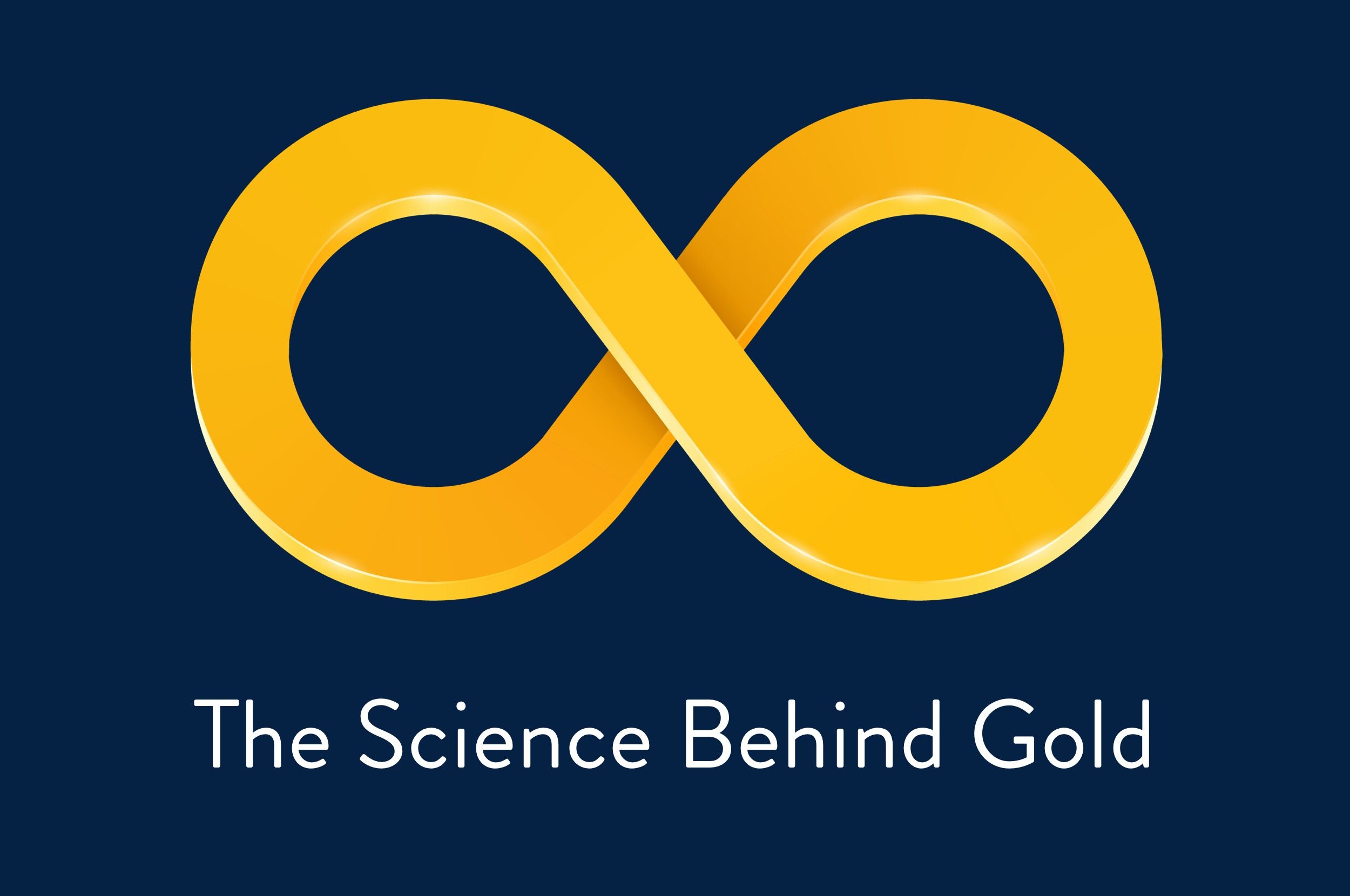
Why Gold — The Science Behind Gold
By: Roy Sebag and Josh Crumb
Goldmoney’s mission is to provide global access to gold for secure savings and transactions, making an extraordinary element useful and empowering again.
Technology and progress are essentially a history of experiments with elements, and of experiments in cooperation.
At Goldmoney we believe that cooperation and saving in gold as a unit of elemental-measurement promotes a more equitable distribution of wealth and opportunity, and aligns prosperity within the natural limits of our planet. In an age of rapid change and limited opportunities for secure savings, we contend that saving in gold can empower individuals and foster cooperation.
By reexamining the elemental properties of gold, it becomes clear that gold provides a globally neutral, natural unit of account in relation to all other elements required by humans. The scientific properties of gold in our natural and human systems reconciled independently over thousands of years. We ask you to consider an alternative view of gold’s usefulness, one absent the emotive politics of money, fear and greed.
Elements, Oxygen, Time
Everything known to exist in the universe, on this planet, and even life itself can be broken down to 92 naturally-occurring elements, the basic building blocks of everything.
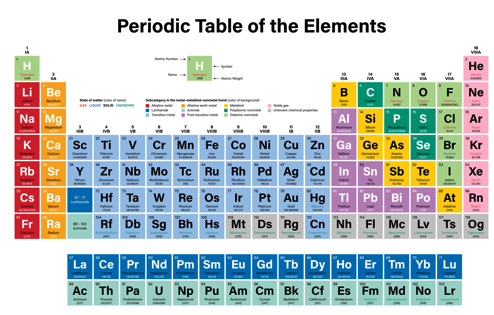
The elements, or combinations of elements (compounds) most desired by humans become known as natural resources, or natural resource commodities. All industry on planet earth, from farming to manufacturing to technology is based on the consumption of these resources; agricultural, fishing and forestry products, hydrocarbon energy sources, and metals.
Oxygen is the third most abundant element and enables life, but also reacts with many of the compounds we require, eventually destroying these resources through cycles. Over time, oxygen causes nearly every commodity to rot, tarnish, rust, or oxidize, establishing an expiration date or finite life for most of the things we consume.
The finite life of most compounds means that we cannot save what we need to survive beyond a limited period of time.
Gold — The Rarest, Immortal Commodity
Of the 92 naturally occurring elements, eight are known as the “noble metals”. The elemental particles making up these eight elements are organized in a manner that makes them unreactive with air, or “immortal” as pure elements. Put differently, the oxygen, carbon dioxide, and gases that make up our air have no tarnishing effect on these elements through the life cycles of humans.
Of the eight noble metals, only four became broadly employed as commodities: gold, silver, platinum, and palladium. Of the four, gold is the rarest on earth and visually discernible due to its color and purity.
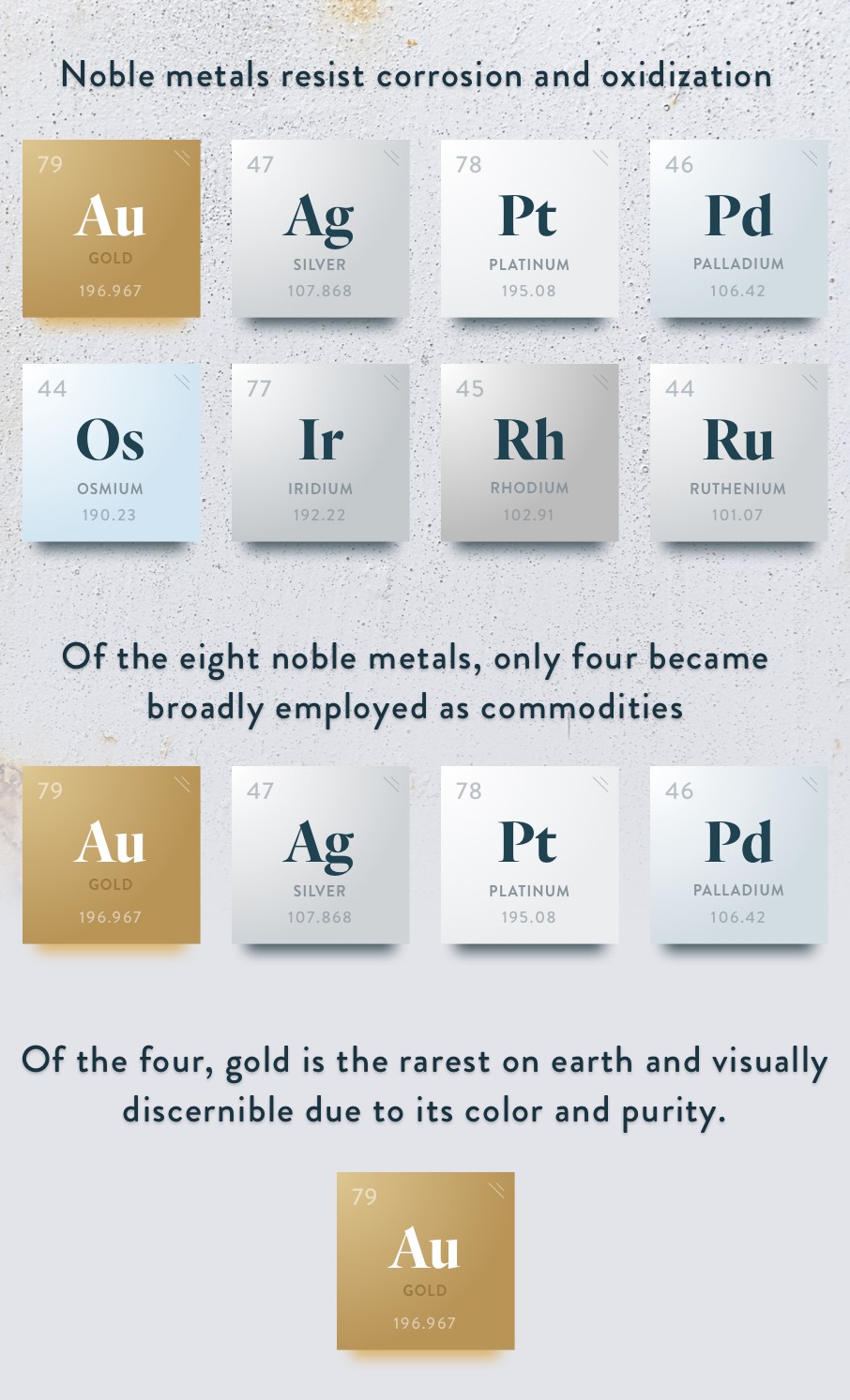
In day to day life gold is rarely preferred over other basic elements or immediately necessary commodities. Grains are more useful as food, energy sources for heat and transport, industrial metals for shelter, tools, and to distribute electricity and data.
None of these daily commodities last over long periods of time in their most useful form however; they are costly to store, costly to transport, or costly to reconfigure if they can be repurposed.
These perishable compounds and commodities do not last throughout the life of an individual either; a younger, physically able person cannot save the essential commodity surpluses for later and less able years.
Therefore, the storage and movement of the basic elements we need requires cooperation, and gold has been an important part of this cooperation throughout history. We’ll explain how, but first we need to know a little about its cost and value.
Opportunity Cost and Gold
Because gold is substantially rarer than the elements and compounds we need to survive, producing gold requires humans to forego production of the more immediately necessary or desired elements or resources.
As an example of this opportunity cost, humans dig up a ton of average copper-containing rock, and spend all the labor and energy required to break it down, we are able to extract 5,000 grams of copper. For this same effort we would only get 1 gram of gold from a ton of average gold-containing rock.
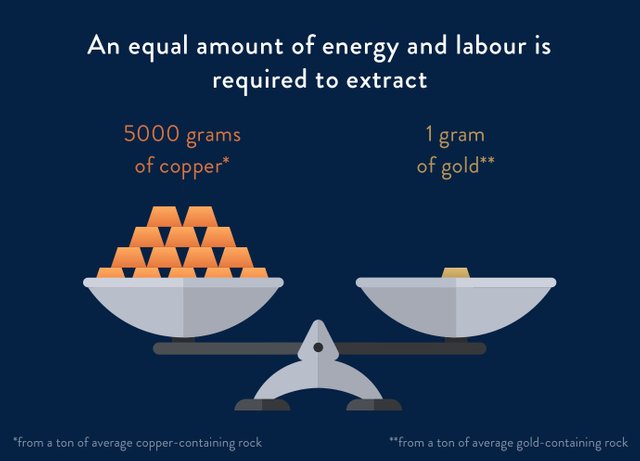
Compared to our food and energy resources, we have to exhaust a lot more of these other resources in order to produce gold, all depending on the relative abundance of elements.
For this reason gold as an element remains cost-proportional to all other basic resources over time, even if all short term values fluctuate depending on local conditions or immediate needs.
Finding Value in a Unique Element
Because it requires substantial effort to produce gold, and that we forego alternate uses of near term energy, labor and food to produce it, there must be important uses for it.
Relative usefulness is defined by the laws of physics, not subjective economics, and gold’s properties and usefulness are significant.
Gold doesn’t decay or tarnish in our atmosphere, it conducts energy over long periods of time without breaking down, its density and malleability enable very small amounts of gold to be extremely useful in thin layers or small spaces, and its noble metal properties mean that it doesn’t react with most other elements, meaning that it’s purity, luster and radiance are effortlessly maintained through millennia.
These elemental properties define gold’s usefulness as a commodity, a commodity whose cost will always remain proportional to the cost of other elements due to the earth’s relative endowment.
These are the properties we found most useful during our experiments with the elements, but we learned an even greater use in our experiments with cooperation.
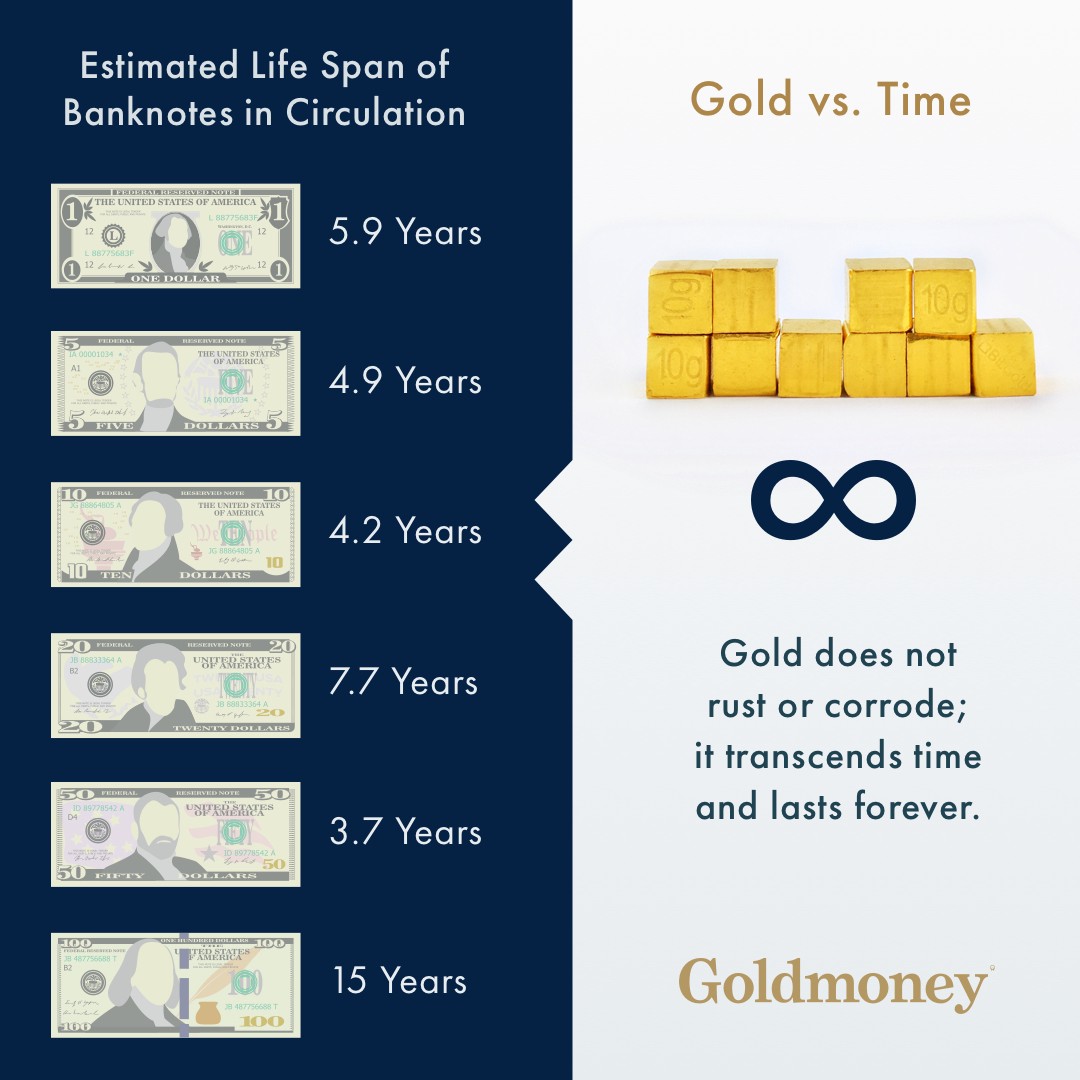
Finding Value in an Element that Transcends Time with Little Cost or Effort
Cooperation and sharing enable us to produce more for everyone than we could ever achieve individually. Over time this cooperation is essential, otherwise young and old would have no way to survive; there is no way to produce for yourself when young, and no way store essential commodities for an old age. This is the basis of the formation of community.
The development of cooperation and trust requires a system of accounting for each community’s production. It is wasteful, if not impossible, to bring all perishable goods to one place at one time for trade, and with no ability to redistribute or save a surplus.
The function of community through sharing therefore requires one of two systems: 1- a complex system of remembering debts and favors, or 2- (preferably) a lasting-intermediate commodity that can be exchanged over and over with very little cost, to be possessed in the interim of exchanges of the essential, immediately useful, but quickly decaying commodities.
Over thousands of years of experiments, civilizations consistently resolved that gold was the most useful element to possess and trade as an accepted form of value.
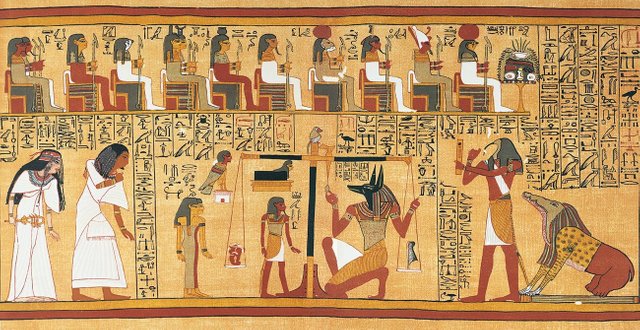
Gold’s elemental properties afford this usefulness, as gold only needs to be produced once but is extremely efficient over time, it can be exchanged perpetually with very little cost compared to the cooperative value it brings. Gold was first a natural resource desired for its elemental properties and usefulness, but one that eventually achieved the more important role of enabling widespread cooperation.
Gold is an Elemental Unit of Account and Elemental Store of Value; in the Past, Present and Future
Gold’s value as an elemental unit of account and store of value is both scientific and natural, as opposed to economic.
Interestingly, gold’s ascension occurred before civilizations had the advanced scientific knowledge of its elemental properties. Humans productively optimized their experiments in cooperation by using gold as the basis for measuring value.
While systems of money and debt come and go, gold will always remain an extraordinary element. Gold’s relationship to other natural resources is bound by the limits of our shared planet. All industry originates in natural systems, and any cooperative economic system should hold a unit of account anchored in these natural systems. Gold provides a pure, elemental measurement.
As we advance the digital age of global cooperation, individuals and communities will increasingly require globally relevant, globally accepted intermediate-commodities for savings and trade.
At Goldmoney, we advance cooperation among diverse communities by providing global access to gold; easily acquired, securely stored, global payments.
For the latest analysis and interpretation of the precious metal markets, be sure to subscribe to Goldmoney Insights. https://www.goldmoney.com/research/goldmoney-insights
The views and opinions expressed in this article are those of the author(s) and do not reflect those of Goldmoney, unless expressly stated. The article is for general information purposes only and does not constitute either Goldmoney or the author(s) providing you with legal, financial, tax, investment, or accounting advice. You should not act or rely on any information contained in the article without first seeking independent professional advice. Care has been taken to ensure that the information in the article is reliable; however, Goldmoney does not represent that it is accurate, complete, up-to-date and/or to be taken as an indication of future results and it should not be relied upon as such. Goldmoney will not be held responsible for any claim, loss, damage, or inconvenience caused as a result of any information or opinion contained in this article and any action taken as a result of the opinions and information contained in this article is at your own risk.
I really enjoyed this article, a couple of months ago, when I first read it @goldmoney-inc! I love economics and the history of how money is selected in each culture.
This essay describes an element that I hadn't considered.
A young man thinks he has no need to save, because his back is strong and his necessary commodities for life are easy to obtain.
He will find when he gets old, that he has outlived his supply of saved food, lumber, etc. Even though he stored away extra, they didn't last.
Gold is a way to preserve that value, for eternity. To buy what you need later, without loss over time.
Thanks for reading “The Science Behind Gold” @jbcoin!
Thx for this great post #GOLDMONEYISEVERYWHERE
That is true @rival! Goldmoney has clients in 150 countries all over the world.
Great reference. Why is gold precious? I gotta be honest i didn't finish reading it. But it's on my list to finish up. Top notch post brother. Thank you.
Thank you for reading “The Science Behind Gold.”
This is a fantastic article! It really makes it Easy to understand why Gold is so unique and valuable and why it is a great means to store the value of our time and talent.
Thank you for reading!
Your post is very informative and i also think its as reliable too.Thank's a lot for sharing such a nice post.@upvoted
Hi! I am a robot. I just upvoted you! I found similar content that readers might be interested in:
https://thedailycoin.org/2018/01/18/gold-science-behind-gold/
Amazing steel post
Spamming comments is frowned upon by the community.
Comment spam is currently defined by @steemcleaners as:
10 or more generic comments per day that are not in response to a question posed by the post or comment. “Thanks”, “Great Post!”, “Informative Post” , “Great Photo!”, “Good”, “Like”, “Nice”, “Wow”, “Cute”, “Follow me”, etc.
Commenting on old posts to hide self up-votes or a voting trail.
Copy/Paste comments that serve no purpose or the purpose is self promotion (including copying and pasting similar comments in rotating way).
Comments that inform the contributor that they have been up upvoted, resteemed, or flagged when the curator does not actually upvote, resteem, or flag the post.
Fishing/farming votes by using multiple accounts to comment on posts by known comment curators.
Unsolicited and off topic referral links.
Continued comment spamming may result in action from the cheetah bot.
More Info: Abuse Guide - 2017.
wow.... nice post @goldmoney ... i like your Why Gold — The Science Behind Gold post
interesting! I would like to investigate more about the subject! break paradigms!
regards know me @nasrul71 from indonesia, your posting is very helpful, my permission to follow you @goldmoney-inc
Nice to meet you,,,